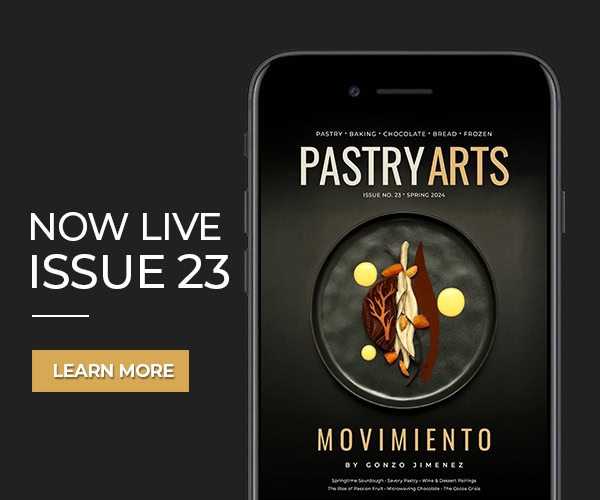According to many sources in the bridal industry, June, September and October remain the most popular months to get married in the United States. With pastry chefs and cake decorators gearing up for the usual busy seasons, a trend is emerging, though it would be a stretch to call it “new.” Buttercream, the old pastry standby, is making a strong comeback as both a coating and decorating medium for wedding cakes. Updated techniques and bold color make what was old new again, and these stunning creations are sure to make any newlywed couple swoon.

In recent years, the popularity of elaborate fondant creations lost some ground to the other extreme, the naked cake. Adorned with nothing but a hint of buttercream and perhaps a flower or two, naked cakes took over dessert tables all over the country. But as the rise in rustic themes and barnyard chic melded with a more traditional wedding aesthetic, buttercream began to emerge as an alternative. Many cake designers and artists have watched this trend develop, including Holley Brashear of Crumbcoat Confections in Harrisburg, PA. “I have seen the demand for fondant cakes steadily decline. More people are wanting buttercream, and they will even change the design of a cake to allow for it to be completely buttercream,” she notes. Buttercream can offer a classic, elegant look that isn’t as trendy as the naked cake, while it also avoids the perceived formality and off-putting taste of fondant. Liz Shim of Eat Cake Be Merry in Houston, TX has also seen an increase in buttercream requests from clients. She says that beyond the aversion to the taste of fondant, she attributes it to “the fact that people are seeing that more can be done with buttercream now than in the past.”

Buttercream, of course, never really went away. Many bakeries and caterers only ever worked in buttercream, regardless of trends. It was often touted in the bridal industry as the “affordable option” to brides on a budget, and it still is. Bridal websites like The Knot recommend it as a budget friendly alternative to fondant, though that is not always the case. Penny Stankiewicz, Chef Instructor at the Institute of Culinary Education and owner of Sugar Couture in New York, NY, aptly points out that her cakes per slice start out at the same base price, regardless of whether they are covered with buttercream or fondant. Decoration will ultimately be the determining factor, and considering the new stunning designs being created with buttercream, that old notion of affordability may no longer be much of a consideration.

One bridal trend report dubbed the newer buttercream floral techniques as “edible botanicals” for their rich use of color and array of various flowers. Leslie Vigil, a cake artist based in Ontario, CA, made the switch to all buttercream a few years ago. “I knew that if I didn’t want to be stuck creating the same roses, mums and blossoms over and over again, I needed to change my approach with a different and unconventional new way.” She expanded her repertoire to include cacti and succulents, creating lush, garden inspired looks. Vigil relies on high quality gel colors and her own secret buttercream recipe for her piped creations, which go beyond flowers to also include vibrant, intricate tapestry layouts. And just as the naked cake trend still lingers with this floral upgrade, ornate buttercream flowers are even keeping the cupcake trend alive. They can be individual or placed together into a large bouquet that would rival any wedding table centerpiece.
Regardless of the particular recipe each cake guru may use, the consensus is that meringue-based buttercreams are the way to go. Shin uses Swiss meringue buttercream exclusively and says it works best when cool to keep the decorations intact. The texture of this type of buttercream also lends itself well to palette knife painting, another increasingly popular technique that achieves that “edible botanical” look. Stankiewicz describes it as having “perfection in the imperfection” and Brashear agrees that she sees this trend on the horizon along with other more “organic” elements like bark and moss.
If brushing up on skills are necessary to take on the newer floral piping or palette knife techniques, classes are popping up online and in many regional cake shops. Shearer and Shin both offer online classes through their websites as well as in-person workshops. Vigil also offers in-person workshops, and Stankiewicz has extensive offerings on cake techniques through the recreational division at the Institute of Culinary Education. Most classes cater to students of any level, but all the chefs note that they most certainly have professionals attending classes to further their skill set.
And for those who prefer to work with fondant, do not fret! There are many designers who stress that buttercream is not always right for certain cakes. Advising a client that fondant is required for execution is in the professional’s best interest as well as the client’s. Stankiewicz, a steadfast fondant supporter, says that the medium “has to make sense for the design and it has to make sense for the place,” emphasizing the limitations of buttercream to hold up in hot weather, for instance. Brashear steers clients towards fondant for sculpted cakes and certain ruffling techniques, and Shim reminds clients that only fondant will achieve that porcelain finish. Discussing possibilities and limitations of either medium with a client is key. Shim states it best when she said, “In the end, I take into consideration the design that the client wants and suggest which medium is best suited to achieve that.” After all, it is the professional who knows best.

Photos credits: Leslie Vigil, Eat Cake Be Merry, Crumbcoat Confections







You must be logged in to post a comment.